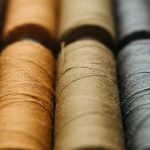You can iron polypropylene fabric, but you need to be very careful because it melts easily at high temperatures. Use a low heat setting around 110°C (230°F), avoid steam, and always place a pressing cloth between the iron and fabric to prevent damage. Test a small, hidden area first, and keep ironing time short to avoid warping or melting. If you want to keep your polypropylene looking good longer and explore safer alternatives, there’s more helpful info ahead.
Table of Contents
Key Takeaways
- Polypropylene fabric can be ironed only at low temperatures, ideally around 110°C (230°F), using the “synthetics” iron setting.
- Avoid steam and direct iron contact to prevent melting, warping, or releasing harmful fumes from the fabric.
- Always test ironing on a small hidden area first and use a pressing cloth to protect the fabric’s surface.
- Consider alternatives like steaming at a distance, hanging in a humid environment, or rolling in a damp towel to remove wrinkles.
- Check care labels before ironing, keep the fabric clean and dry, and minimize iron contact time to avoid permanent damage.
Understanding Polypropylene Fabric Properties
Polypropylene fabric stands out for its lightweight and durable nature, but it also has a low melting point that demands careful handling. When you work with this material, you’ll notice it’s resistant to stains and moisture, making it popular for activewear and outdoor gear.
However, its low thermal resistance means it can easily melt or warp under high heat. Unlike cotton or polyester, polypropylene doesn’t tolerate the typical ironing temperatures. It’s also less breathable, so you might feel warmer wearing it in hot conditions.
Knowing these properties helps you recognize why standard fabric care methods don’t always apply. Once you understand how polypropylene behaves, you can better protect your clothes and maintain their appearance without risking damage from heat or improper treatment.
Why Polypropylene Fabric Needs Special Care
Because this fabric melts at relatively low temperatures, you have to handle it with extra caution when ironing or washing.
Polypropylene is sensitive to heat, so even moderate warmth can cause it to warp or lose its shape. You’ll notice it doesn’t respond like cotton or polyester, so using traditional ironing methods can damage the fibers quickly.
Additionally, polypropylene is hydrophobic, meaning it repels water, which affects how detergents and heat interact with it during washing. This property also means it dries fast but can be tricky to clean thoroughly without harming the fabric.
To keep your polypropylene items looking their best, you need to treat them gently and avoid exposing them to high heat or harsh cleaning agents. Special care helps maintain their durability and appearance over time.
Risks of Ironing Polypropylene at High Temperatures
You shouldn’t iron polypropylene at high temperatures because it melts easily, which can ruin your fabric.
Applying too much heat risks deforming the material, leaving it misshapen or shiny.
Knowing these dangers helps you protect your clothes and keep them looking great.
Melting Point Dangers
When ironing polypropylene fabric, watch the temperature carefully to avoid melting it. Polypropylene has a low melting point around 320°F (160°C), so even slight overheating can cause irreversible damage. If you’re not cautious, the fabric can instantly melt, ruining your garment.
Here are key dangers of overheating:
- Surface Melting: The fabric can become sticky and deform where the iron touches it.
- Fumes: Melting polypropylene releases unpleasant, potentially harmful fumes.
- Permanent Damage: Once melted, the fabric loses its structure and can’t be restored.
To keep your polypropylene items safe, always use a low heat setting or a protective cloth between the iron and the fabric. Avoid direct contact with hot surfaces to prevent these melting risks.
Fabric Deformation Risks
Although polypropylene can handle some heat, ironing it at high temperatures risks serious fabric deformation. When you apply too much heat, the fibers can warp, shrink, or lose their original shape.
This distortion isn’t just cosmetic—once the fabric deforms, it can affect the fit and durability of your garment. You might notice uneven surfaces, puckering, or areas that feel stiff and brittle.
To avoid these issues, always use a low heat setting and test on a hidden section first. Using a pressing cloth can also help distribute heat evenly and protect the fibers.
Recommended Ironing Temperature for Polypropylene
You’ll want to set your iron to a low heat, typically around 110°C (230°F), to protect polypropylene fabric.
Using a temperature above this can cause melting or damage.
Always check your iron’s settings and start low to keep your fabric safe.
Ideal Heat Settings
Setting your iron to a low temperature is essential for safely ironing polypropylene fabric. Since this material is heat-sensitive, using high heat can melt or warp the fibers.
To protect your garment, follow these ideal heat settings:
- Use the lowest iron setting, typically labeled “synthetics” or around 110°C (230°F).
- Avoid steam, as moisture combined with heat can damage the fabric.
- Always test on a small, hidden area first to guarantee no adverse effects.
Temperature Guidelines for Polypropylene
When ironing polypropylene fabric, keeping the temperature below 110°C (230°F) is essential to avoid damage. You should use the lowest heat setting on your iron, usually labeled “synthetic” or “delicate.” Avoid steam, as moisture combined with heat can cause the fabric to warp or melt. To help you visualize, here’s a quick guide:
| Temperature (°C) | Iron Setting | Effect on Polypropylene |
|---|---|---|
| 50 | Low | Safe, no damage |
| 80 | Synthetic/Delicate | Safe, gentle smoothing |
| 100 | Medium Low | Caution, test first |
| 110 | Medium | Max recommended, avoid long contact |
| 130+ | High | Risk of melting and warping |
Stick to these guidelines to keep your polypropylene fabric looking great.
How to Prepare Polypropylene Fabric Before Ironing
Preparing polypropylene fabric before ironing requires careful attention to avoid damage.
To get your fabric ready, start by checking the care label for any specific instructions. You’ll want to make certain the fabric is clean and dry since dirt or moisture can cause uneven heating or stains.
Finally, test a small, hidden area with your iron’s lowest heat setting to verify it won’t melt or warp.
Here’s how to prepare polypropylene fabric effectively:
- Inspect and follow the care label guidelines.
- Confirm the fabric is completely clean and dry.
- Perform a spot test on an inconspicuous section.
Step-by-Step Guide to Ironing Polypropylene Safely
You’ll want to set your iron to a low temperature to avoid melting the polypropylene fabric.
Always use a pressing cloth or towel between the iron and fabric to protect it from direct heat.
Following these steps will help you iron safely without damaging your fabric.
Temperature Settings
Setting the right temperature is essential to avoid damaging your polypropylene fabric. Since polypropylene melts at relatively low temperatures, you’ll want to keep your iron on a low setting to prevent warping or melting.
Follow these tips for safe temperature control:
- Use the lowest heat setting or a synthetic fabric setting on your iron.
- Avoid using steam, as moisture combined with heat can deform the fibers.
- Test the iron on a hidden area first to guarantee it doesn’t cause any damage.
Protective Measures
Controlling the temperature is just one part of keeping your polypropylene fabric safe during ironing.
First, always use a pressing cloth between the iron and the fabric to prevent direct heat contact, which can melt or deform the fibers. Make certain the iron is clean to avoid transferring residue onto the fabric.
Next, use the steam function sparingly or avoid it altogether, as excess moisture can affect polypropylene’s texture. Iron on the reverse side of the fabric whenever possible to further reduce heat exposure.
Keep the iron moving steadily—don’t hold it in one spot. Finally, test on a small, hidden area before ironing the entire piece.
These protective measures guarantee your polypropylene fabric stays smooth and damage-free.
Alternatives to Ironing Polypropylene Fabric
Although ironing polypropylene fabric can be tricky due to its low melting point, you can use several effective alternatives to remove wrinkles without risking damage.
These methods help maintain the fabric’s integrity while keeping it smooth and presentable. Here are some alternatives you might find useful:
- Use a Steamer: A handheld steamer gently relaxes fibers without direct heat, reducing wrinkles safely.
- Hang in a Humid Environment: Hanging the fabric in a bathroom during a hot shower lets steam naturally ease out creases.
- Smooth by Hand: Lay the fabric flat and gently stretch and smooth it with your hands to lessen wrinkles.
Tips for Removing Wrinkles Without Heat
How can you effectively remove wrinkles from polypropylene fabric without using heat?
Start by hanging the fabric in a steamy bathroom. The moisture helps relax fibers and smooth out wrinkles naturally.
Hang polypropylene fabric in a steamy bathroom to naturally relax fibers and reduce wrinkles without heat.
You can also gently spritz the fabric with water using a spray bottle, then smooth it out with your hands.
Another method is to roll the fabric tightly in a damp towel and let it sit for 15 to 30 minutes—this can help release creases.
If you have a garment steamer, use it on a low setting, keeping the steamer a few inches away to avoid damage.
These techniques protect polypropylene from heat-related issues while keeping your fabric looking crisp and fresh.
Common Mistakes When Ironing Polypropylene
When you iron polypropylene, using too high a temperature or pressing the iron directly on the fabric can cause melting or permanent damage.
Avoid these common mistakes to keep your fabric looking its best:
- Don’t skip the protective layer. Always use a pressing cloth to shield the fabric from direct heat.
- Avoid steam settings. Polypropylene doesn’t respond well to moisture and heat combined, which can cause warping.
- Don’t leave the iron in one spot for too long. Constant movement prevents scorching and shiny spots.
Long-Term Care to Maintain Polypropylene Fabric Quality
To keep your polypropylene fabric looking fresh over time, you’ll need to adopt consistent long-term care habits.
Always wash it in cold water with mild detergent to prevent damage and color fading. Avoid bleach or harsh chemicals that can weaken the fibers.
Wash polypropylene in cold water with mild detergent; avoid bleach to protect fibers and color.
When drying, air-dry your polypropylene items or use a low heat setting in the dryer to maintain shape and integrity. Store the fabric away from direct sunlight and heat sources to prevent degradation.
If wrinkles appear, use a low-temperature iron with a pressing cloth or opt for steaming instead. Regularly inspect for any wear or damage, repairing small tears promptly.
Frequently Asked Questions
Can Polypropylene Fabric Be Dyed After Ironing?
Oh, sure—just iron your polypropylene and magically expect it to dye perfectly afterward! Actually, once heated, it resists dyes more stubbornly. So, if you want color, dye first, then handle heat carefully to avoid damage.
Does Ironing Affect the Waterproof Properties of Polypropylene?
Ironing polypropylene can damage its waterproof coating because high heat melts the fibers. You shouldn’t iron directly; instead, use low heat and a pressing cloth to avoid ruining the waterproof properties and keep the fabric intact.
Can You Use Steam When Ironing Polypropylene Fabric?
You shouldn’t use steam when ironing polypropylene fabric because the moisture and heat can damage it. Instead, use a low-temperature dry iron and place a cloth between the iron and fabric to protect it from melting or warping.
How Does Polypropylene React to Other Heat Sources Besides Irons?
Imagine touching fire—polypropylene shrinks and melts with most heat sources besides irons. You’ll want to avoid direct flames or high dryers, as they’ll damage the fabric quickly, ruining its texture and shape.
Is It Safe to Iron Polypropylene Fabric With Prints or Coatings?
You shouldn’t iron polypropylene fabric with prints or coatings directly. The heat can damage or melt them. Instead, use a low heat setting, place a cloth over the print, and avoid steam to keep it safe.
- Schoeller Keprotec®: The Ultimate Aramid Fabric for Abrasion Resistance - June 23, 2025
- Proper Care and Recovery of Aramid Fabrics - June 23, 2025
- Plain Weave vs. Twill Weave Aramid Fiber Fabric: A Comparison - June 23, 2025







